The streets of Gdansk are filled with a rich history and dramatical events. You can now easily explore it all with the help of this thorough itinerary for a walking tour of Gdansk. Are you ready to explore this Baltic gem?
The Pomorskie region, located close to the Baltic Sea, is a well-known destination for those of us looking for rich culture and affordable luxury. But there is also a lot to indulge in for the history enthusiasts amongst us. The jewel in the Pomorskie crown – or should I rather say the amber in the crown – is undoubtedly the city of Gdansk.
Over the centuries, Gdansk has been a city of traders and merchants, the home of mighty kings, a city left in ghostly ruins after a disastrous war, it has been the cradle in which the Polish Solidarity movement was born, and now, in more recent years, it has been the beating heart of Pomorskie tourism. In other words, there’s an abundance of things to be discovered. In this guide, we have created a thorough itinerary for those of you looking for a historical walking tour of Gdansk. If you, on the other hand, prefer exploring the history of Gdansk with the help of a local guide, I can highly recommend booking a tour with Agnieszka. Even the legendary Rick Steves recommends her – you can check out all of her excellent reviews here.
Are you still here? Ok, good. Let’s start walking, shall we?
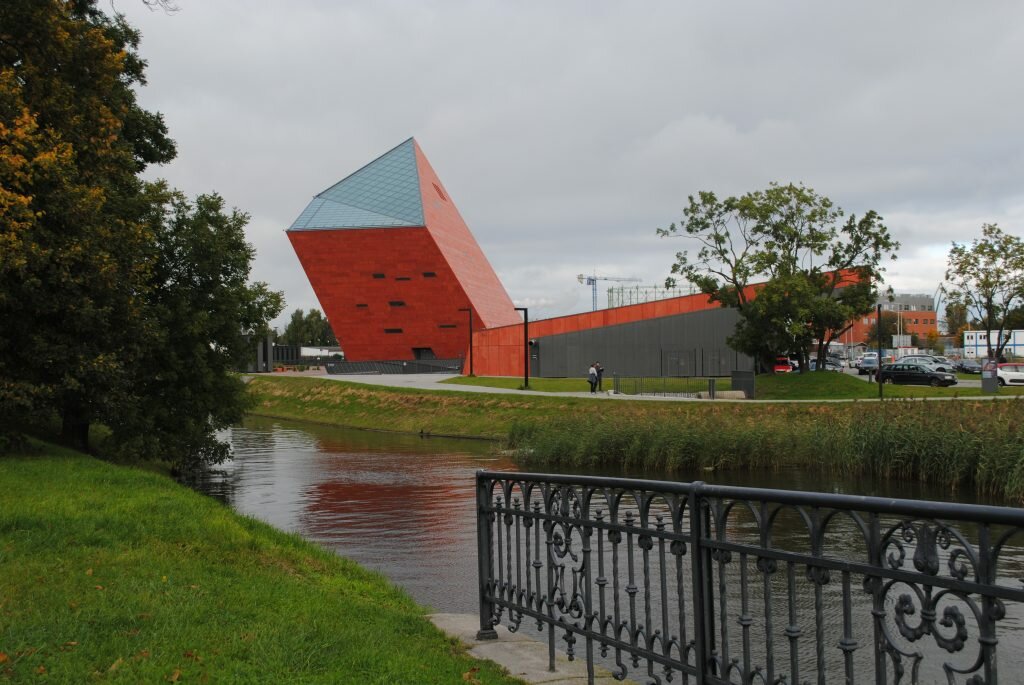
The Museum of WW2 is an interesting piece of architecture that you need to experience during your visit to Gdansk.
Finding History: Walking Tour Gdansk
This detailed itinerary will take you to the following places in Gdansk
- The Coal Market
- The Torture Chambers
- The Old Town
- St. Mary’s Basilica
- The Museum of Solidarity
Make sure you have enough time to properly visit the places you walk past on this walking tour – and there’s no need to worry: this guide also consists of restaurant recommendations (and the occasional drinking place). I’ve got you covered, you know.
The Coal Market
Our day starts at the town square which once used to be the old Coal Market. On your right hand (facing the Old Town), you will find a brick building which will be the first stop of the day. The Coal Market was once a place for public executions, so it might not come as a surprise that the brick tower on your right used to be the city’s prison and torture chamber.
Today, the building is the home of two separate museums. The first part of the museum, the Amber Museum, is dedicated to what is one of the strongest symbols of Gdansk and the Pomorskie region: amber. For those of you who are utterly confused right now, amber is a fossilized tree resin. Characterised by its beautiful colour, the amber is actually recognised as a precious gemstone. The Amber Museum contains an interesting exhibition, but it is undoubtedly the second museum which is most popular amongst tourists.
The Museum of Torture will be your second stop of the day. The prison was once notorious for its use of torture equipment (they can definitely give the Spanish Inquisition a run for their money!), and here you have the opportunity of walking around in the old prison cells, to learn interesting and terrifying facts about the torture equipment and public executions, and watch real graffiti on the walls created by desperate prisoners. After spending an hour here, you will probably think that Fifty Shades of Grey is for pussies.
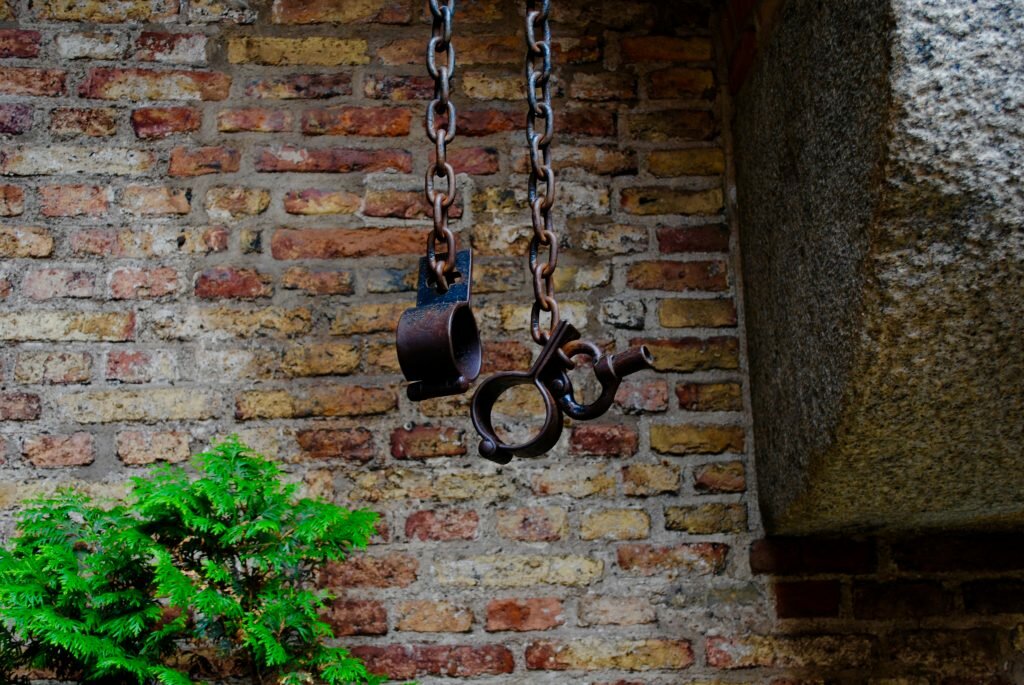
The old torture chamber in Gdansk will make you realise that the Fifty Shades films are for pussies…
Before heading towards the next step of your walking tour, you will catch a wee glimpse of a round brick tower to the left of the Golden Gate. This is the old gunpowder tower. Are you ready for a fun fact? The roof of the building was originally made of straw! You might be laughing now, but it was actually incredibly clever. If the gunpowder accidently exploded, it meant that the roof would simply be blown off – instead of ruining the entire building!
That’s what I would call amazing damage control.

The old Gunpowder Tower used to have a ceiling made of straw to prevent explosions from ruining the building.
The Golden Gate: Entering Gdansk Old Town
The beautifully ornated Golden Gate is the original entrance to the Old Town of Gdansk. However, the Old Town is really not as old as you initially might think. Instead, you should take in the view and remember that the entire city was left in ruins after 1945. After the end of the war, there was nothing but ghostly ruins where the beautiful Old Town had once been.
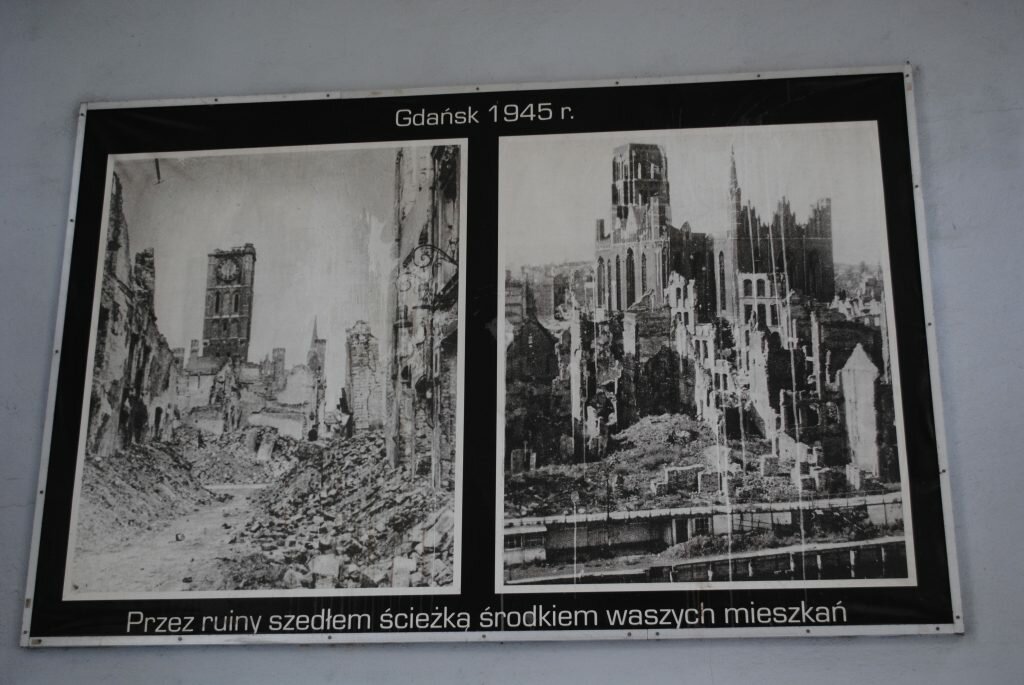
In the Golden Gate, you can find original photos of how Gdansk looked after 1945. The city was later rebuilt.
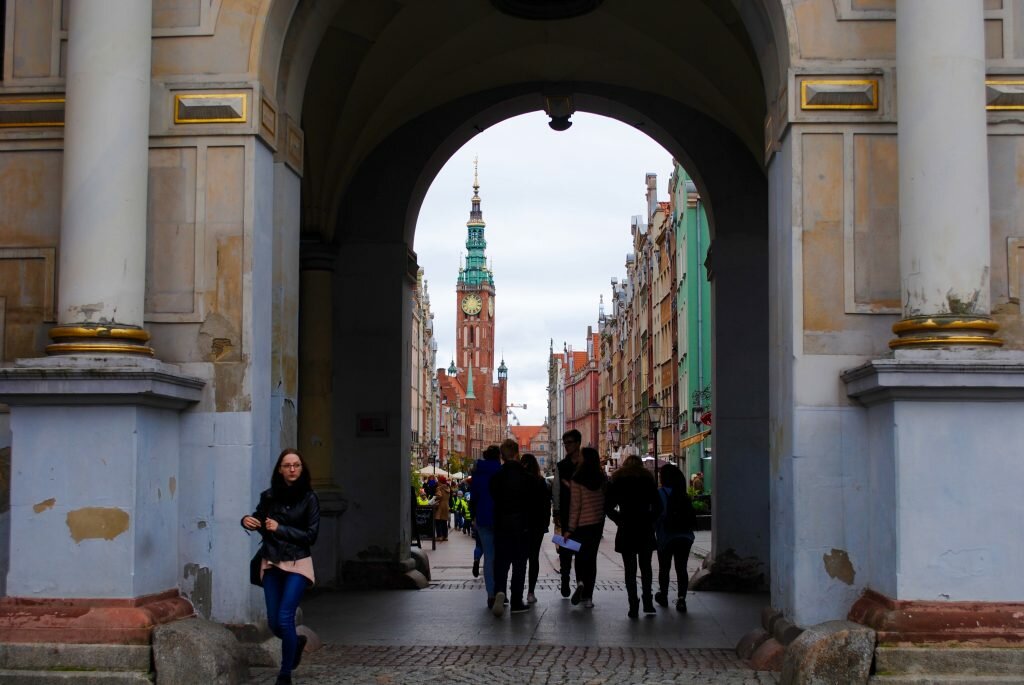
The Old Town seen from the Golden Gate.
The Russians made Gdansk citizens rebuild the old city in the 1950s, so the houses you see today are just copies of what once used to be there. The houses are also often a lot smaller than the original houses, this is because the builders tended to only rebuild the facade and front part of the deep, narrow buildings. Despite this, it still provides a historical outlook on how the vibrant merchant city once used to be.
Before we move on, here’s a fun fact for all those nerdy fun fact-lovers out there on the interwebs (I love fun facts. I throw them around like glitter):
In the heart of the Old Town, you will find both the impressive City Hall and the Neptune Fountain. However, if you look closely at the symbols on the City Hall you will find a mistake. The two lions, the symbol of Gdansk, are actually looking the wrong way. The official symbol always portrays the lions looking towards each other, but on the City Hall they are both facing the same way (to the left). The official excuse is that the lions wanted to see the king arriving down from the Golden Gate. No one really knows why, but it’s definitely an interesting part of Gdansk’s art history.
The Beating Heart of Gdansk Old Town
Gdansk has always been a multicultural city, and even today you can find traces of all its different influences. In 1552, while Europe was busy fighting citizens with wrong religious beliefs, the king in Gdansk led the way with religious tolerance. Jews, Protestants, Muslims and Catholics were all welcome in Gdansk as long as their businesses could bring money to the city. For the king, the sound of coins clinging was far sweeter than the religious and political disputes happening elsewhere.
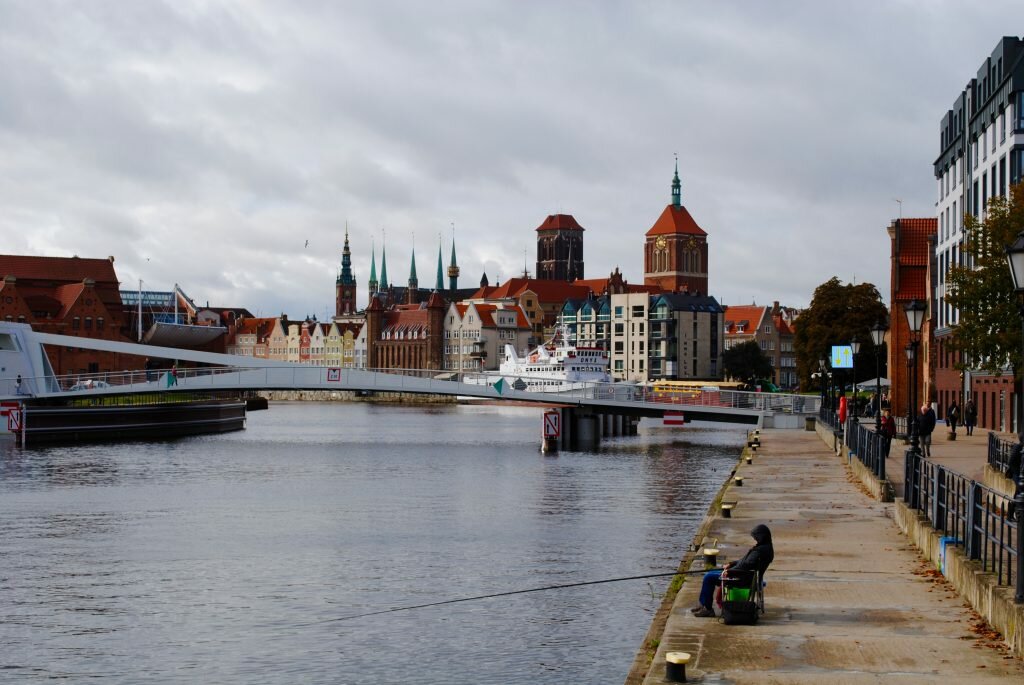
As a result of this, Gdansk accepted lots of European refugees. One of the many people that found their way to the Baltic city, was Fahrenheit – the inventor of, um well, Fahrenheit. The parents of young Fahrenheit arrived from Germany, and Fahrenheit was actually born in Gdansk. The family was quickly welcomed to the vibrant city. The joy, on the other hand, was not meant to last. Fahrenheit’s parents tragically died after picking poisonous mushrooms in 1701.
After all the walking, I’m quite sure you could use a quick break. It’s time to head into one of the many bars in the old Town and order the most well-known drink in the Pomorskie region – the infamous Goldwasser (Gold water). Goldwasser is a highly alcoholic spirit that was originally developed in Gdansk, although today it’s mostly produced in Germany. And before you ask – yes, Goldwasser contains real gold. Alchemy was highly popular in the late 16th century when the liquor first appeared. Goldwasser was originally created for medical purposes, it was a common belief that gold could aid digestion.

You will find plenty of places that offers the infamous Goldwasser
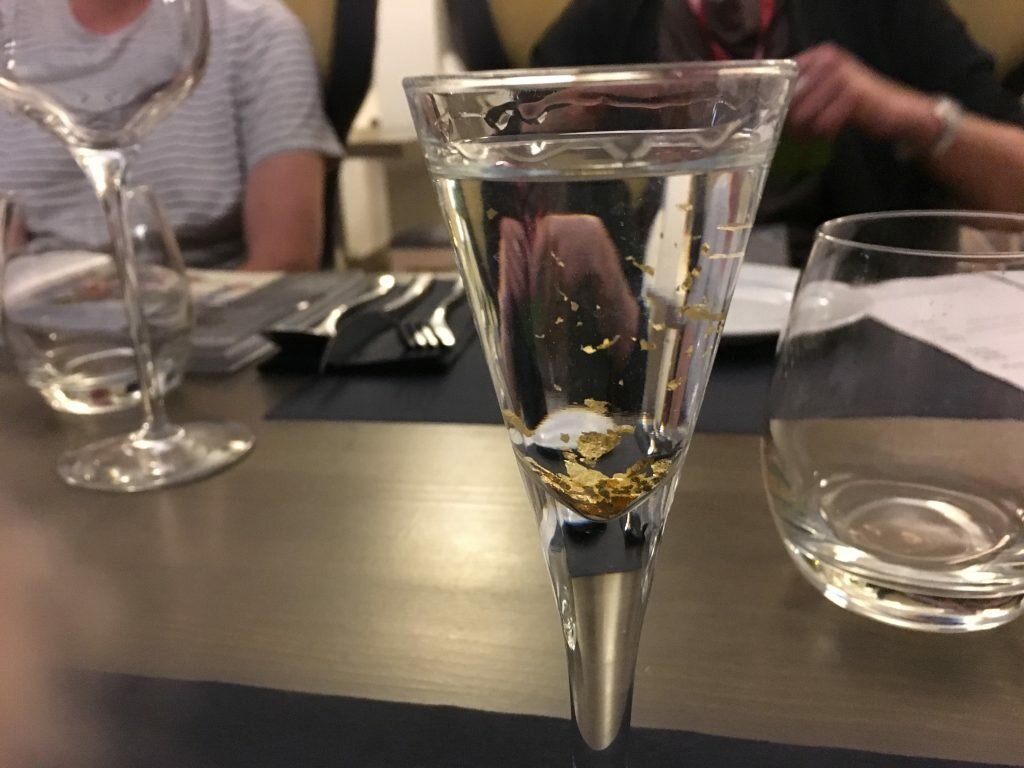
The famous Goldwasser
Na zdrowie!
St. Mary’s Basilica
St. Mary’s Basilica, Bazylika Mariacka, is undoubtedly one of the most impressive buildings in Gdansk. It’s an old Roman Catholic Church, and it’s said to be the largest brick church in the entire world. It can hold up to 25,000 people at once, and it was a popular place to seek refuge during the period of martial law (1981-1983) that followed the outbursts of the Solidarity movement (but more on that later, guys!).
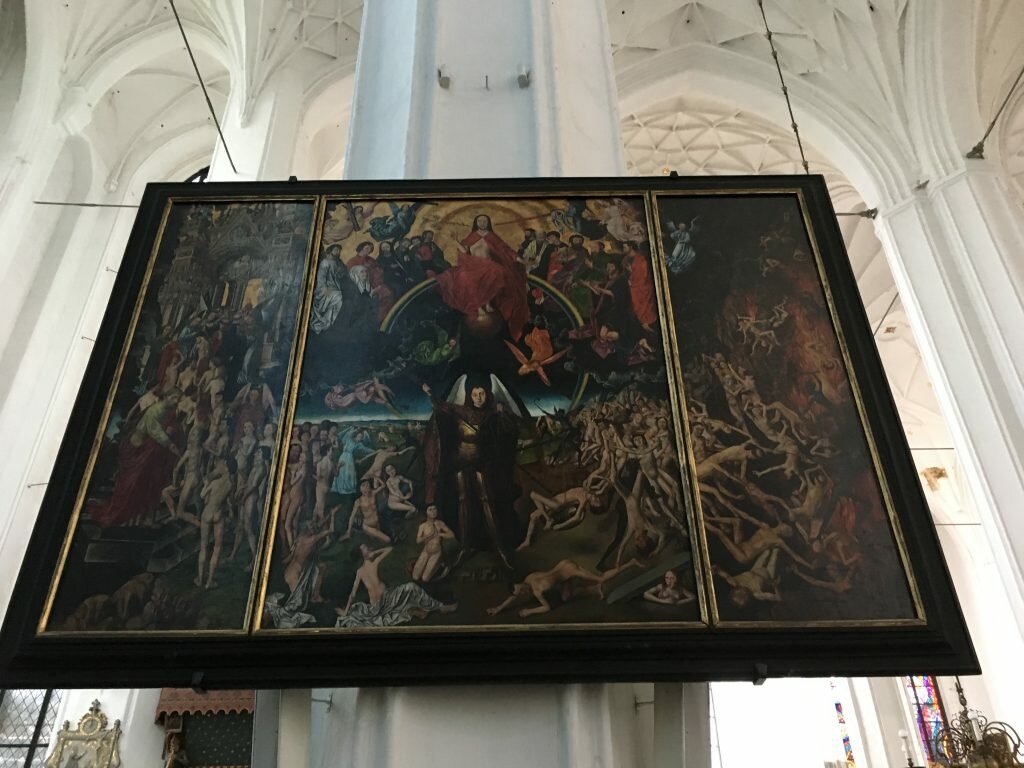
The Last Judgement
The basilica can offer its visitors a glimpse of a 15th-century astronomical clock, surprisingly similar to the more famous astronomical clock in Prague. My personal favourite is a huge copy of Hans Memling’s The Last Judgement – it was once stolen from Florence by traders from Gdansk. The original can be found in the National Museum.
As the name reveals, the painting portrays a rather popular scene in Christian art, namely the last judgement. What separates this painting, however, from those of its time, is the fact that the people who are weighed and found heavy, are the ones being sent to heaven. If you know your art history, you’re probably aware that this is the complete opposite of more common Christian depictions of this scene. Normally, it’s the people being found light that are being sent to Heaven. This can all be explained by the fact that Hans Memling was an avid follower of St Augustine – a thinker who is known for believing that all good things were heavy.
(Yet another fun fact. I told you I throw them around like glitter).
Lunch Break at Piwna 47
After a long morning spent exploring Gdansk, it’s about time to treat yourself to a decent lunch. My favourite restaurant in Gdansk is conveniently located right outside of St. Mary’s Basilica, and it comes highly recommended – it was even recommended by the Wine Spectator in 2016 for its excellence.
It’s also worth mentioning that Piwna 47 is part of Pomorskie Prestige – a project which is carefully tailored for visitors who want a little extra during their time in the Pomorskie region. The culinary project focuses on flavours that can naturally be found in the Pomorskie region, and the aim is to produce excellent culinary experiences which are all rooted deep in the regions history and with local products. In other words, if you see a restaurant marked as Pomorskie Prestige you will know that you’re in for a treat. In general, the Pomorskie Prestige project is all about slow, local food and affordable luxury.
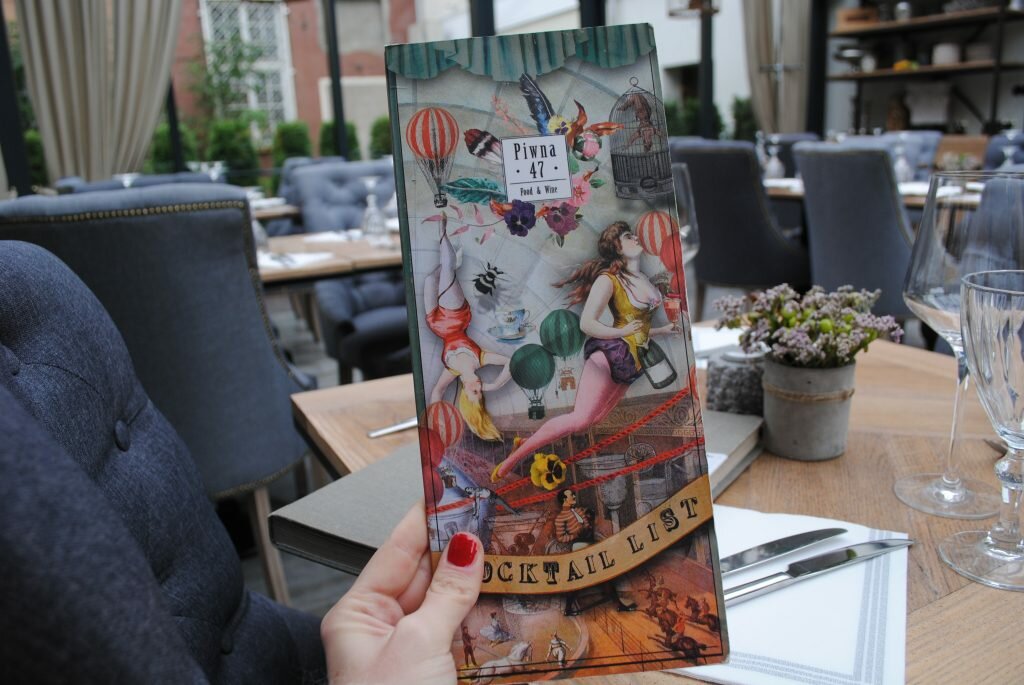
Not only is this the cutest restaurant in Gdansk – it also offers an amazing cocktail menu!
Besides an incredible cocktail menu, Piwna 47 also offers delicious food based on ingredients found in the local area. If you’re looking for foodie recommendations, I will highly suggest that you try the żurek soup as a starter. Żurek, a sour rye soup with served with sausage and eggs, is local to Poland and Belarus and it tastes absolutely divine (and that’s coming from a girl that normally avoids all kinds of soups…).
READ MORE: 5 Must Try Foods in Poland
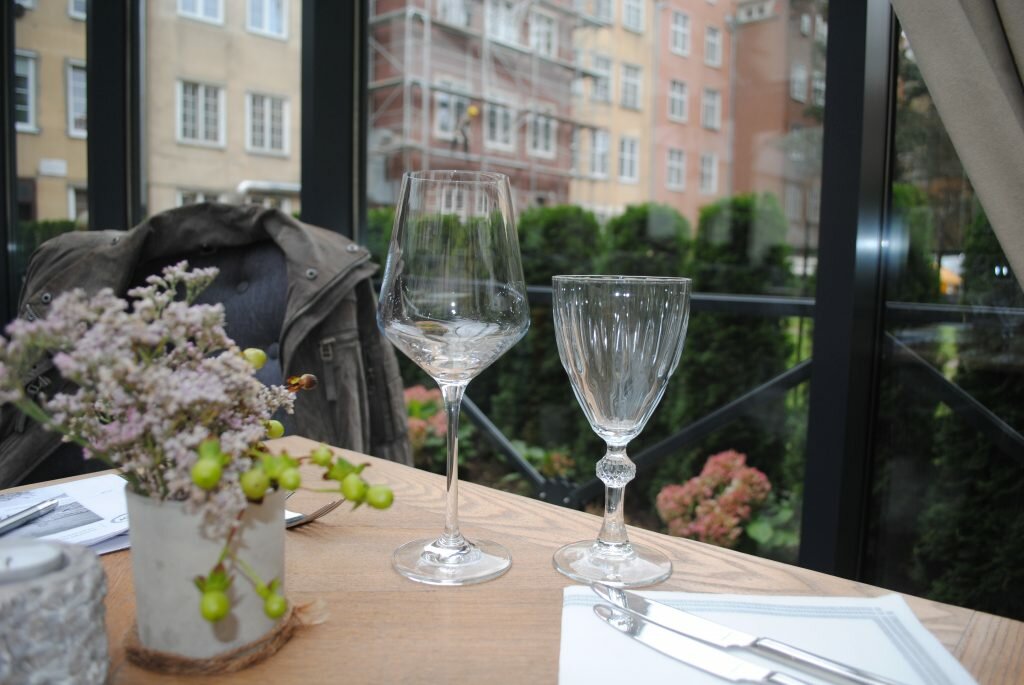
Fancy a glass?
Museum of Solidarity
After an amazing meal at Piwna 47, it’s about time to walk off all that deliciousness. Head back down to the canal, and follow it all the way to the Museum of Solidarity. Optional for tired legs: take the tram. Optional for lazy legs: take a taxi.
The Museum of Solidarity is a must-see in Gdansk. The museum is located right next to the entrance of the Gdansk Shipyards, and it was officially opened in 2014 – on the 34th anniversary of the signing of the famous August Accords. The building is covered in a rust-coloured metal that reminds of a ship’s hull, thereby bringing the shipbuilding past of Gdansk back to life. The museum was awarded the prestigious Council of Europe Museum prize for 2016. Outside the museum, the OHS Hall, the Solidarity Square and Monument to the Fallen Shipyard Workers of 1970 have been awarded the European Heritage Label.
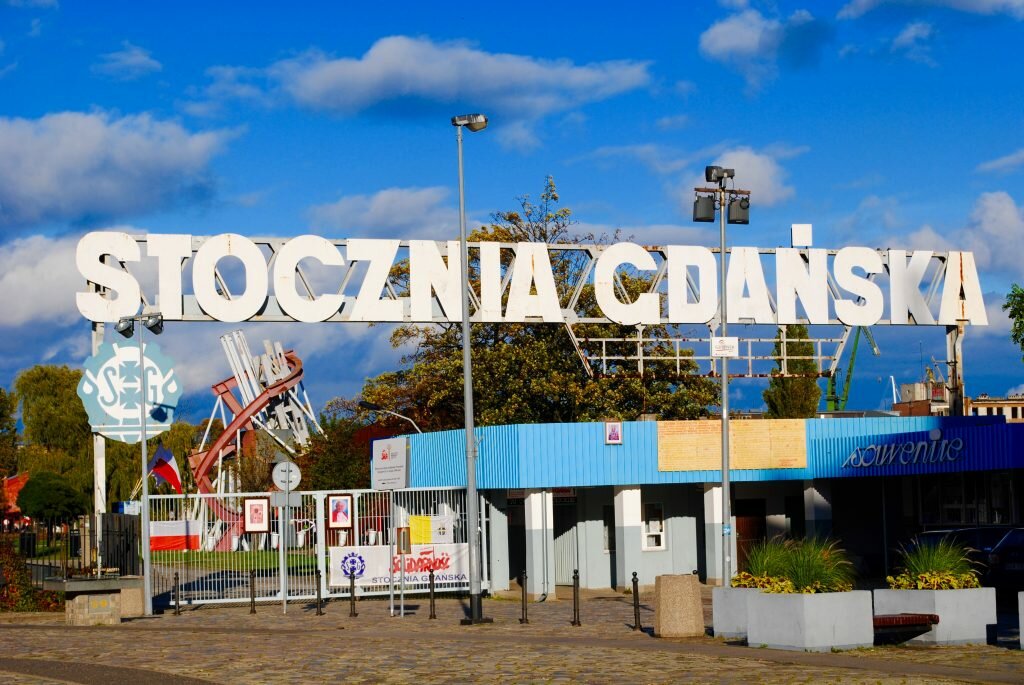
The original entrance to the old shipyard in Gdansk.
In general, the museum contains a permanent exhibition on the history of Solidarity, the Polish opposition movement that eventually led to the democratic transformation of the countries in Central and Eastern Europe.
On the square in front of the museum, the Solidarity Square, you will find an impressive monument dedicated to all the workers that lost their lifes during the original protests in 1970. The protest started due to an increase in food prices, and it led to a huge strike in Gdansk. The government urged workers to get back to work, but the Polish People’s Army and the Citizen’s Militia were afraid of another riot and opened fire towards the crowd of workers emerging from the morning trains. More than 1000 people were wounded, and it’s often reported that around 40 people died. The exact number of deaths is not known since the government concealed the news. The murdered workers, which were said to die of kidney problems, were buried overnight with only the closest relatives present.
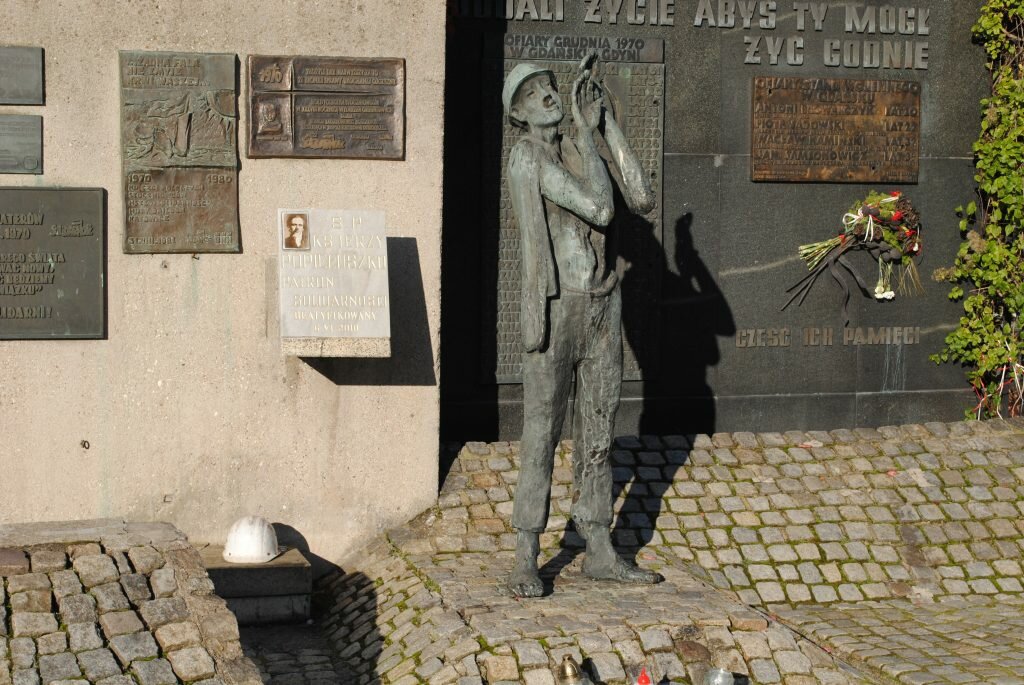
There are several monuments dedicated to the fallen workers.
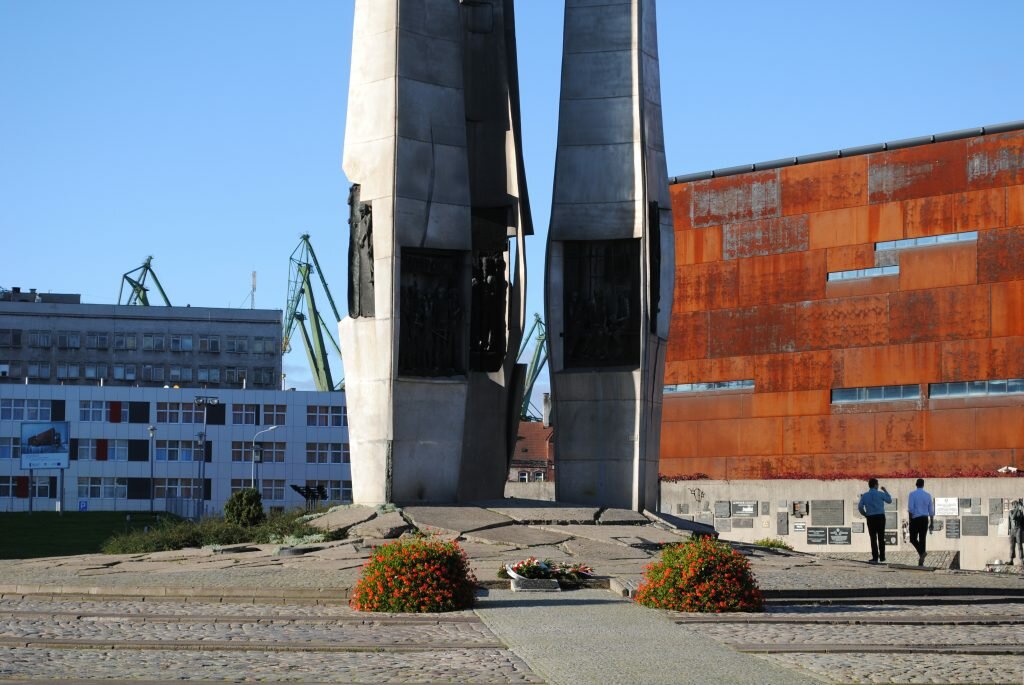
The Museum of Solidarity is a must-see during your stay in Gdansk.
The museum traces the birth of the Solidarity movement back to the riots of 1970, and in the exhibition you can follow Poland’s political development all the way to the fall of communism.
Final stop: Brewery Tour at Hotel Gdansk
Well done for finishing your Walking Tour Gdansk! It’s been a long day, so why not finish the exploration with a taste of real history?
Hotel Gdansk is a historical boutique hotel perfectly located near the main canal in Gdansk. Furthermore, the hotel is very popular because it has its own mini brewery, Brovarnia! In 2011, their Scwarzbier (a dark beer) was awarded the title of the best beer in Poland! That’s a proper achivement, if you ask me!
If you ask in advance, a brewer will take you and your friends on a proper beer tour at the hotel. If you’d rather just sit and enjoy a pint (or two), then that’s perfectly acceptable too. Beware, a few times a year they even brew a limited edition beer, so that is definitely worth showing up for!
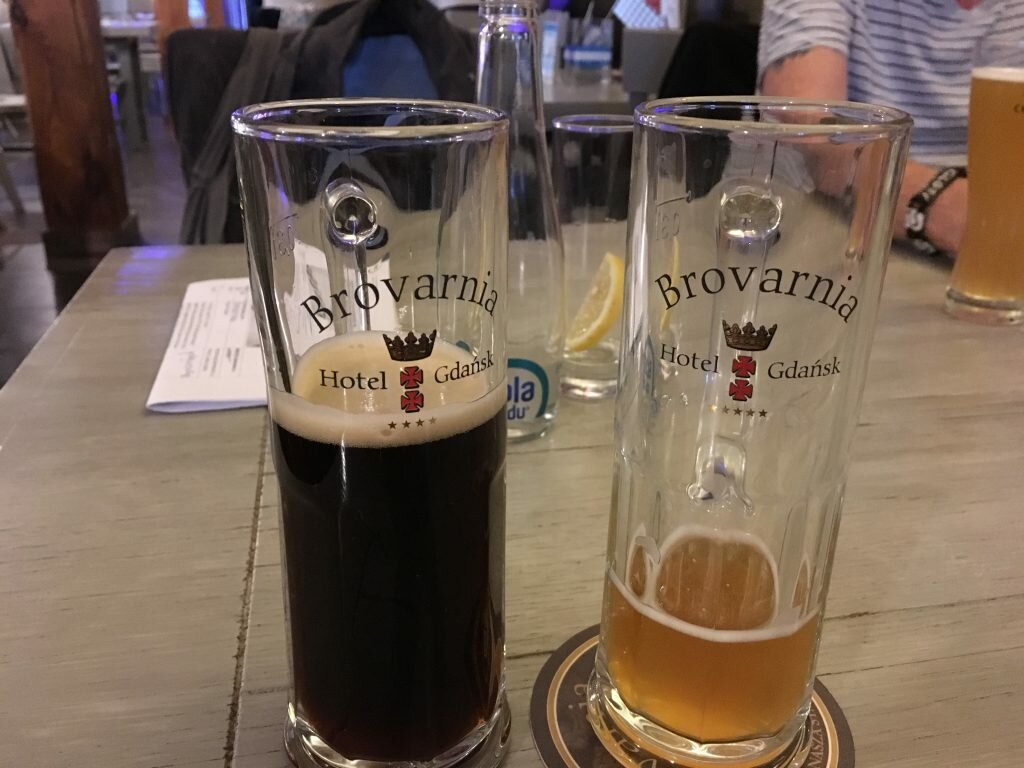
Disclosure: Cavaforlunch.com was invited to Gdansk as a guest of the tourism board in Pomorskie, Poland. However, all opinion are, as always, completely my own (and so are any mistakes I might have possibly commited in this thorough itinerary). #LifestylePolen #PomorskieAdventures
But tell me: Have you ever been to Gdansk? And what was your favourite part of the city?
Like This? Pin it!
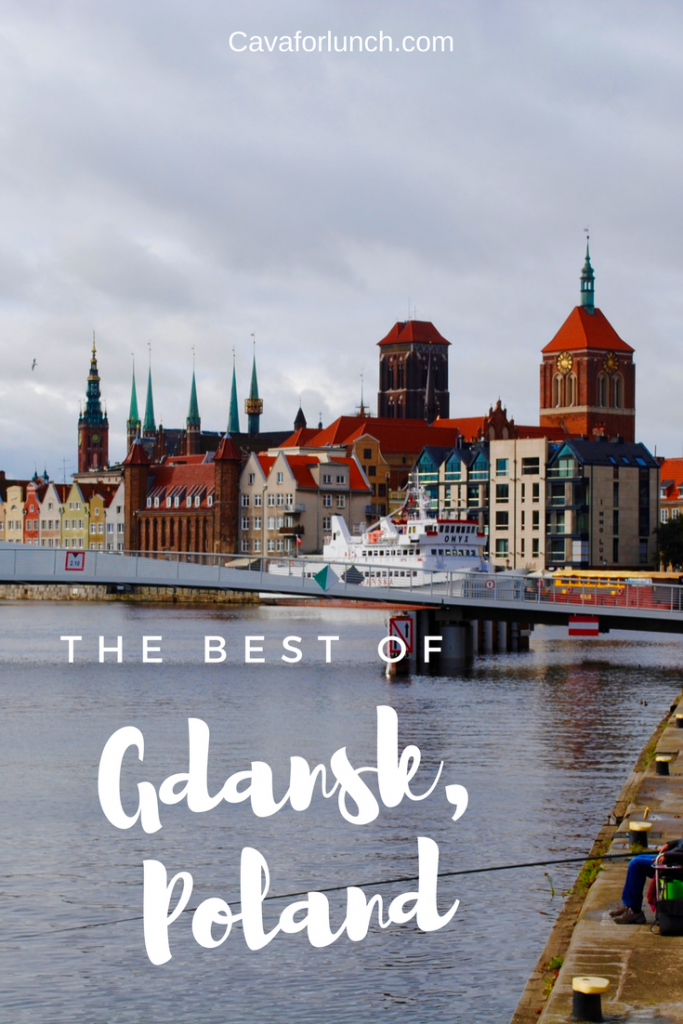




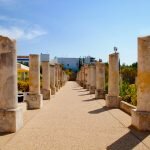

21 comments
Gdansk sometimes has industrial associations and is known for the destruction suffered during World War Two but it looks a fascinating place to visit. I like how you have structured your post and the photos you have used.
Not going to lie, that Gold Wasser looks really cool, but I’m probably too much of a lightweight to have much of it! I’m always down for a walking tour, and Gdansk seems to have a lot to see.
Ha! I’m such a lightweight as well – but I just soldiered on, tbh ;)
Jeg var i Gdansk i fjor, og likte byen veldig godt. Gamlebyen er flott, og solidaritetsmuseet var imponerende og interessant. Spiste god og billig mat, møtte mange hyggelige folk og var på flere herlige dagsturer til forskjellige steder i Nord-Polen (!).
Hei Marianne!
Ja, Gdansk var virkelig helt fantastisk. Det blir definitivt ikke mitt siste besøk i Polen! Kan du anbefale noen andre spennende dagsturer i Polen? :)
Jeg så du har vært i Sopot, der er det jo fint :-D Ellers brukte jeg en dag på roadtrip blant annet til en nasjonalpark med sanddyner ved kysten, og var på dagstur med tog til middelalderbyen Torun. Begge disse turene kan anbefales, har skrevet om dem på bloggen :-)
I loved it! My family is from Gdansk – so I know for a fact how good you wrote it :)))
Thank you, Karolina! That’s lovely to hear xx
Beautiful post! I have only been to Wroclaw in Poland but now I have put Gdansk on my list too :-) And btw, cocktails and wine for lunch are always a great idea ;-) Cheers!
Can you ever go wrong with cocktails for lunch? ;)
But indeed, Gdansk is such a stunning city and it got so much to offer. I would definitely recommend a visit sometime soon :)
I’ve heard so many wonderful things about this city and your photos are just gorgeous! this makes me want to go visit pronto!
Do it! You’ll love it!
Det er veldig interessant! Kjaeresten min har familie i Polen og vi skal kanskje reise dit neste år, det blir gøy å se flere steder i dette landet. Gdansk ser ganse fint ut men jeg hadde aldri hørt om denne byen!
Da anbefaler jeg virkelig at du tar turen innom for å sjekke ut Gdansk – det er virkelig en helt fantastisk by!
Goldwasser looks very intriguing – but actually, so does this entire city. It definitely hasn’t been on my radar up until this point (as in, I’d heard of it, but hadn’t considered travelling there), but it sounds like the kind of blend of interesting history (I can’t believe they rebuilt the old town, I never would have guessed from the photos!) and architecture that I enjoy.
I completely agree with you, Gdansk is such a hidden gem. I actually liked it so much that I booked another trip in just a few weeks… x
I love walking tours! You learn so much and it’s better (in my opinion) than riding in a bus all afternoon. Poland is definitely on my list!
This city is beautiful and looks so rich in culture and history. Just my kind of cities, honestly.
I enjoy walking tours as there’s so much you can discover while doing so.
Love this post.
Looks like a super interesting place! Poland is on the bucket list for next year so will add this place in!
Wow Gdansk has so much to offer! I love history and I love finding lesser known places to visit. I have only been to Krakow in Poland and loved it but when I get to Gdansk this will be my guide! Thanks for all the info!
Thanks so much for this – visiting Gdansk in January and going to follow this walking tour on one of the days! Great post, super excited now! :-)